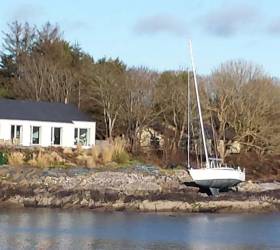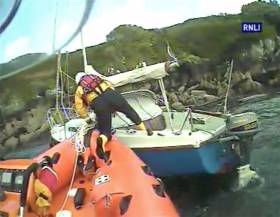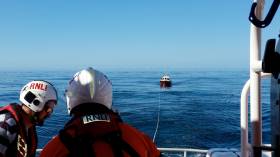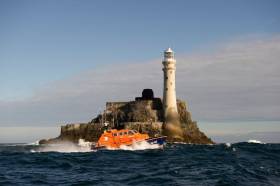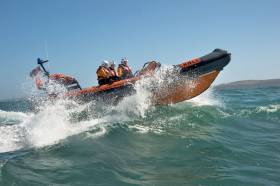Displaying items by tag: west cork
Baltimore Lifeboat Provides Medevac From Sherkin Island
#RNLI - Baltimore RNLI launched yesterday afternoon (Sunday 7 January) to provide a medical evacuation from Sherkin Island.
The volunteer lifeboat crew launched their all-weather lifeboat following a request from the Irish Coast Guard at 3.50pm to provide medical assistance and evacuation for an elderly man on the West Cork island.
Once on scene, the volunteer lifeboat crew administered casualty care before transferring the patient back to the all-weather lifeboat, which returned to Baltimore lifeboat station at 4.20pm to transfer the patient to the care of the waiting HSE ambulance crew.
There was a north-easterly Force 4-5 wind at the time but sea conditions within the harbour were calm.
Speaking following the callout, Baltimore RNLI volunteer lifeboat press officer Kate Callanan said: “The RNLI and other rescue/emergency agencies provide a vital service to those living or staying on islands around the coast of Ireland. If you are in difficulty on or near the coastline call 999 or 112 and ask for the coastguard.”
There were eight volunteer crew onboard the lifeboat: coxswain Kieran Cotter, mechanic Cathal Cottrell and crew members Brendan Cottrell, Jerry Smith, Don O’Donovan, Kieran Collins, Micheal Cottrell and Eoin Ryan. In attendance at the lifeboat station was Kate Callanan.
Last weekend, Baltimore RNLI launched twice in the same day for a medevac from Heir Island and to assist bodyboarders reported in difficulty at Barleycove, as previously reported on Afloat.ie.
#RNLI - Baltimore RNLI launched twice in the space of a few hours yesterday (Friday 29 December) — firstly to provide a medevac from Heir Island, and later to assist bodyboarders in difficulty at Barleycove.
The volunteer crew launched their all-weather lifeboat Alan Massey following a request from the Irish Coast Guard at 11.16am to provide medical assistance and evacuation to a woman who fell on Heir Island off the coast of West Cork.
Once on scene, the crew administered casualty care before transferring the patient to the all-weather lifeboat and returning to Baltimore to meet a waiting HSE ambulance crew.
Conditions at sea during the shout had a north-westerly Force 6-7 wind and a one-metre sea swell, heralding Storm Dylan’s approach this weekend.
The crew launched a second time, at 4.18pm, after a member of the public alerted that three bodyboarders were in difficulty off Barleycove, near Mizen Head in West Cork.
The wind had eased considerably since the first callout, with a south-westerly Force 3-4, but there was a rough sea state with a swell of 3-4m.
At 4.45pm, with the lifeboat four miles west of West Calf Island, the crew were asked to stand down by the Irish Coast Guard after the three bodyboarders had made it safely ashore.
Speaking following the callouts, Baltimore RNLI volunteer lifeboat press officer Kate Callanan said: “With strong winds forecast over the coming days, the Irish Coast Guard strongly advises to exercise caution in coastal areas and reminds people to ‘Stay Back, Stay High and Stay Dry’.
“If you see someone in difficulty in the sea of along the shore call 999 or 112 and ask for the coastguard.”
The volunteer crew on the first callout were coxswain Kieran Cotter, mechanic Jerry Smith and crew members Aidan Bushe, Don O’Donovan, Simon Duggan and Kieran Collins. Ay the lifeboat station were Kate Callanan and John O’Brien. Crew on the second callout were Cotter, Smith, Bushe, O’Donovan, Eoin Ryan and David Ryan.
Crew Leaves Roach-Ridden Trawler Detained In West Cork
#Fishing - A UK-registered fishing boat detained in West Cork last week had to be fumigated twice to remove an infestation of cockroaches.
And according to the Irish Examiner, the Indonesian crew of the trawler Christian M have now walked off the vessel as arrangements are made for their voluntary return.
The Christian M was towed into Castletownbere on Wednesday 8 November after breaking down off the West Cork coast.
A subsequent inspection by the Marine Survey Office (MSO) led to its detention over a number of issues, including the cockroach infestation.
Ken Fleming, a co-ordinator with the International Transport Workers Federation (ITF), visited the boat yesterday (Friday 17 November) along with gardaí and an Indonesian embassy official.
“When I went onboard the vessel, I witnessed cockroaches still on surfaces,” said Fleming. “The accommodation is unfit for purpose.”
The Irish Examiner has much more on the story HERE.
Courtmacsherry Lifeboat Rescues Four On Trawler In Trouble
#RNLI - Courtmacsherry RNLI’s all-weather lifeboat was called out at 7pm on Saturday night (11 November) to go to the aid of an 80ft fishing boat that got into difficulties 15 miles south of the Seven Heads in West Cork.
The Trent class lifeboat, under coxswain Ken Cashman with a crew of five, launched immediately and proceeded at full speed to the distress area as the large trawler with four crew onboard sought assistance.
The stricken vessel was located by the lifeboat at 7.45pm and an immediate tow was put in place, proceeding at low speed back to the safe haven of Kinsale.
Weather conditions in the area at the time were misty with Force 3-4 winds and a strong swell.
Courtmacsherry RNLI lifeboat operations manager Brian O’Dwyer praised the crew for carrying out the rescue with great speed and professionalism.
He also thanked them and all station personnel for skipping Ireland’s important soccer battle in Copenhagen in order to help others in distress.
The crew of the lifeboat were coxswain Ken Cashman, mechanic Stuart Russell, Ciaran Hurley, Conor Dullea, Denis Murphy and Evin O’Sullivan.
Attempt to Refloat West Cork Yacht This Morning
Attempts to recover a 32–foot that went aground in Schul, West Cork during Storm Ophelia get underway this morning.
A recovery team is expected to slide the yacht down the rocks and back into the water using inflated rubber bags.
Elderly Passenger In Medevac From Queen Mary 2 Off Cork
#Medevac - Shannon’s Irish Coast Guard helicopter Rescue 115 was involved in a medevac from the cruise liner Queen Mary 2 some 60 nautical miles off West Cork on Thursday morning (12 October), as BreakingNews.ie reports.
An elderly passenger understood to have a heart problem was treated by the ocean liner’s medical staff before transfer to the coastguard crew, who airlifted him to University Hospital Tralee.
Union Hall Lifeboat Aids Yacht On Rocks In Glandore Harbour
#RNLI - Union Hall RNLI was requested to launch yesterday afternoon (Sunday 10 September) at 4.21pm by Valentia Coast Guard to reports of a yacht that had broken from its mooring in Glandore Harbour and was heading for rocks.
Weather conditions in West Cork at the time were dry with a westerly Force 7 wind, gusting Force 8, and bumpy seas.
The volunteer lifeboat crew were underway at 4.32pm and headed to the yacht just metres from the rocky shore.
Once on scene, a crew member was put aboard the yacht to attach a tow line, and the vessel was pulled to the safety of Union Hall pier.
Speaking following the callout, Union Hall RNLI lifeboat operations manager John Kelleher said the severe windy conditions are set to remain for most of the coming week.
“If you see someone in trouble, please dial 999/112 and ask for the coastguard, and for your safety stay away from exposed coastal areas.”
West Cork Lifeboats Launch To Stranded Tug & Angling Boat
#RNLI - Lifeboats from Baltimore and Castletownbere launched two separate callouts off West Cork since Friday (1 September).
Baltimore RNLI was called out yesterday morning (Saturday 2 September) to a tug with three people on board, which had broken down north of Drowlaun Point off Sherkin Island.
The volunteer crew launched their all-weather lifeboat at 9.45am after they were alerted by the skipper of the 12.5m tug. They arrived on scene seven minutes later and quickly established a tow to Baltimore Harbour within an hour.
Conditions at the time were good, with a southerly Force 4-5 wind and a calm sea ahead of the much poorer weather forecast for later in the day.
Elsewhere, Castletownbere RNLI lifeboat was launched on Friday morning to a 30ft angling boat with mechanical failure three miles south-east of Crow Head on the Beara Peninsula.
The lifeboat, under the command of Coxswain Brian O’Driscoll, was launched on service within minutes and proceeded to the casualty some nine miles southwest of Castletownbere Harbour.
The casualty was located in fine weather conditions at 11.07am. RNLI volunteers passed a towrope to the anglers’ onboard and the lifeboat took the vessel under tow to Castletownbere, where it was berthed alongside the pier 90 minutes later.
Baltimore Lifeboat Launches To Boat Aground In Heavy Fog
#RNLI - Baltimore RNLI launched in the early hours of yesterday morning (Thursday 17 August) after a boat ran aground in heavy fog near the West Cork village.
The volunteer lifeboat crew were paged at 00.39am to assist the 50ft vessel with three people on board. Sea conditions in the area were calm, but visibility was poor due to fog.
Under the command of coxswain Kieran Cotter and with mechanic Cathal Cottrell and crew members Pat Collins, Kieran Collins, Don O’Donovan, Jerry Smith and Micheal Cottrell, the lifeboat reached the vessel within 15 minutes.
After assessing the grounded boat’s situation and checking the surrounding area for any navigational hazards, a tow was established and the vessel was pulled clear.
There was no apparent damage to the vessel and no injuries to anyone on board, so it was allowed to move under its own power Baltimore Harbour, where it arrived escorted by the lifeboat at 1.20am.
Speaking following the callout, Baltimore RNLI volunteer lifeboat press officer Kate Callanan said: “With bad weather forecast for the next few days we would remind everyone taking to the sea to respect the water.”
Earlier in the week, Baltimore RNLI launched on Tuesday night (15 August) after reports of a flare sighted at Gokane Point, near Toe Head.
However, the lifeboat was stood down en route when the Irish Coast Guard learned that the flare was actually a firework set off from land and not a boat in distress.
Elsewhere, Arklow RNLI’s volunteers launched yesterday afternoon following a pager alert to a call for help from a sailing vessel with engine trouble.
In moderate seas, the lifeboat Ger Tigchlearr proceeded to the reported position of the casualty vessel, some four miles north east of Arklow Harbour and with two people on board.
Once on scene, the vessel and crew of the casualty vessel were found be in good order, and a towline was established it bring the boat back to Arklow.
John Tyrrell, Arklow RNLI’s lifeboat operations manager, commented: “Our crew were able to get the casualty vessel in a timely fashion. We would like to commend the skipper of the boat for calling for help at an early stage.”
#RNLI - Baltimore RNLI assisted two sailors yesterday evening (Monday 14 August) after their yacht lost power off Mizen Head in West Cork.
The alarm was raised earlier in the afternoon following a report from the crew of a 26ft yacht that they had lost all battery power.
At the time, the occupants were comfortable sailing the yacht towards Baltimore, so the lifeboat was put on standby until they were closer.
However, due to a confused sea in a strong tideway, the yacht was making very little progress towards land and required assistance to get to port.
The inshore lifeboat, helmed by Micheal Cottrell and with crew members Ryan O’Mahony and Colin Rochford on board, left station at 7.20pm and met the yacht three miles west of Cape Clear Island just before 8pm.
Weather conditions at the time were relatively good, with a Force 3 south-westerly wind and a one-metre sea swell.
One of the lifeboat crew went aboard the yacht to assist with rigging a tow and, once that was established at 8.05pm, a course was set for North Harbour in Cape Clear where the vessel was moored safely at 8.55pm.
Speaking following the callout, Cottrell said: “The sailors did the right thing in initially alerting people ashore to their predicament and then seeking the assistance of the lifeboat before darkness when their situation wasn’t improving.”






























